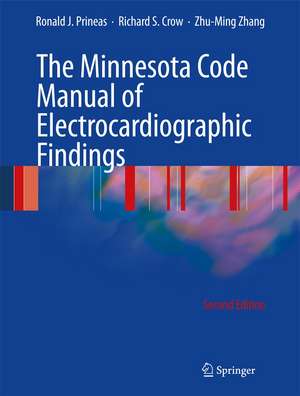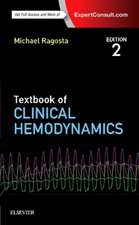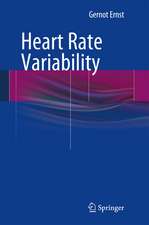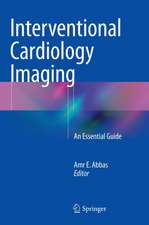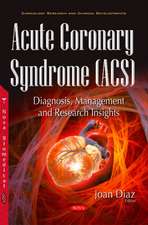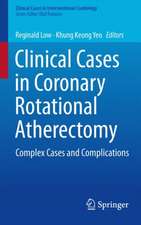The Minnesota Code Manual of Electrocardiographic Findings
Autor Ronald J. Prineas, Richard S. Crow, Zhu-ming Zhangen Limba Engleză Hardback – 8 noi 2009
| Toate formatele și edițiile | Preț | Express |
|---|---|---|
| Paperback (1) | 919.44 lei 6-8 săpt. | |
| SPRINGER LONDON – 22 aug 2016 | 919.44 lei 6-8 săpt. | |
| Hardback (1) | 1312.42 lei 3-5 săpt. | |
| SPRINGER LONDON – 8 noi 2009 | 1312.42 lei 3-5 săpt. |
Preț: 1312.42 lei
Preț vechi: 1381.49 lei
-5% Nou
Puncte Express: 1969
Preț estimativ în valută:
251.16€ • 272.72$ • 210.98£
251.16€ • 272.72$ • 210.98£
Carte disponibilă
Livrare economică 01-15 aprilie
Preluare comenzi: 021 569.72.76
Specificații
ISBN-13: 9781848827776
ISBN-10: 1848827776
Pagini: 314
Ilustrații: XIII, 328 p.
Dimensiuni: 210 x 279 x 20 mm
Greutate: 1.13 kg
Ediția:2nd ed. 2010
Editura: SPRINGER LONDON
Colecția Springer
Locul publicării:London, United Kingdom
ISBN-10: 1848827776
Pagini: 314
Ilustrații: XIII, 328 p.
Dimensiuni: 210 x 279 x 20 mm
Greutate: 1.13 kg
Ediția:2nd ed. 2010
Editura: SPRINGER LONDON
Colecția Springer
Locul publicării:London, United Kingdom
Public țintă
Professional/practitionerDescriere
The manual is suitable for training electrocardio- without digital recording and that are accompanied graphers and technicians and can be accompanied by other uniquely rich data. Despite my expectations by sets of training ECGs already coded by trainers. during the 1960s that such archives would cease to It is our expectation that the manual will serve as a be used after the introduction of digital recording, reference, guide, and training source for those con- the tide of such treasures has hardly ebbed. ducting studies that require objective evidence of The changes included in this edition arise from cardiac disease, both prevalent and incident, by non- more than a quarter of a century of directing central invasive, highly standardized, inexpensive record- ECG reading and research centers and collectively ing of the electrocardiogram. In our own ECG Read- 60+ large and small epidemiologic studies and m- ing Center, this has included epidemiologic studies ticenter national and international clinical trials. The among healthy populations, diabetics, psychiatric changes include the description of a new measuring patients, pregnant women, cohorts of patients with loupe in Chap. 3, developed over the past decade, to clinical heart disease, populations exposed to envi- better serve a more ef? cient and a more extensive ronmental contaminants such as arsenic, populations span for measurement of relevant durations, voltages, exposed to Chagas disease, and in clinical trials of and deviations from the isoelectric line. In Chap.
Cuprins
What Is the Electrocardiogram or ECG?.- ECG Leads.- Measuring Devices.- Q-QS Waves (1-Codes).- Frontal Plane QRS Axis (2-Codes).- High R–Waves (3–Codes).- ST Segment Depression (4-Codes) and Negative T-Waves (5-Codes).- Atrioventricular (A–V) Conduction Defects (6-Codes).- Intraventricular Conduction Defects (7-Codes).- Arrhythmias, 8-Codes.- Miscellaneous Codes (9-Codes).- Exact Measurements.- Coding the Whole ECG.- ECG Data Acquisition Procedures and Maintenance of Recording Quality Including Technician Training.- Criteria for Significant Electrocardiographic Change.- ECG Indices that Add to Independent Prognostication for Cardiovascular Disease Outcomes.- Quality Control of Visual and Electronic Coding.
Textul de pe ultima copertă
The electrocardiogram (ECG) is most often used in clinical and hospital settings for diagnosis and prognosis, but it is also used for systematic population studies and clinical trials where a repeatable, valid, and quantitative method is required for classification of ECG findings related to disease. Useful classification depends, in turn, on standardized methods of acquiring the data, on mounting (sampling), and on efficient and effective reading and measurement of the ECG.
This new edition of the classic reference Minnesota Manual of Electrocardiographic Findings has been prompted by the continuous refinements and extensions to the Minnesota Code that allow a greater range of abnormalities to be coded; there are even clearer means of demonstrating correct and standardized methods of measurements, which are incorporated into this extensively revised second edition; some minor coding rules have been changed; and now the use of the code has been greatly expanded and is used in countless epidemiologic studies and clinical trials worldwide.
While the contents of the coding chapters of this manual need not be mastered in one reading, the manual should be used as a reference when there is doubt about how to measure a particular wave form. The manual should be an important addition to the libraries of electrocardiographers, all clinical trialists and experienced investigators to teach measurement and coding of ECGs. The information contained within these pages is also key reading for all trainee physicians in internal medicine and cardiology, and nurses, technicians and other professionals involved in the management of patients needing ECG evaluation.
This new edition of the classic reference Minnesota Manual of Electrocardiographic Findings has been prompted by the continuous refinements and extensions to the Minnesota Code that allow a greater range of abnormalities to be coded; there are even clearer means of demonstrating correct and standardized methods of measurements, which are incorporated into this extensively revised second edition; some minor coding rules have been changed; and now the use of the code has been greatly expanded and is used in countless epidemiologic studies and clinical trials worldwide.
While the contents of the coding chapters of this manual need not be mastered in one reading, the manual should be used as a reference when there is doubt about how to measure a particular wave form. The manual should be an important addition to the libraries of electrocardiographers, all clinical trialists and experienced investigators to teach measurement and coding of ECGs. The information contained within these pages is also key reading for all trainee physicians in internal medicine and cardiology, and nurses, technicians and other professionals involved in the management of patients needing ECG evaluation.
Caracteristici
Updated to reflect changes in understanding over the last 20 years, this title provides the benchmark for coding in electrocardiographic applications
Constitutes an essential source of reference for clinical trials and population-based cardiovascular studies
Constitutes an essential source of reference for clinical trials and population-based cardiovascular studies
